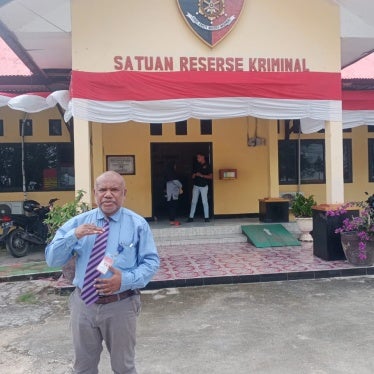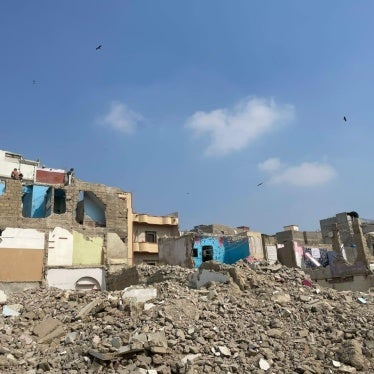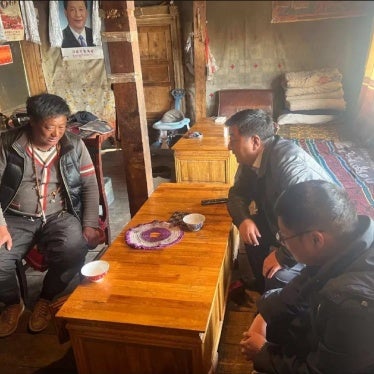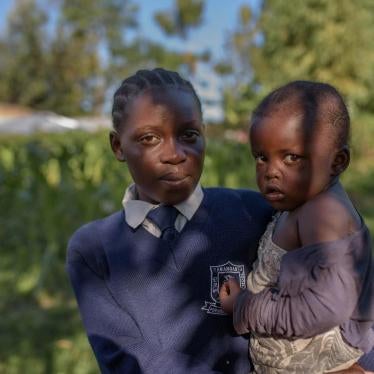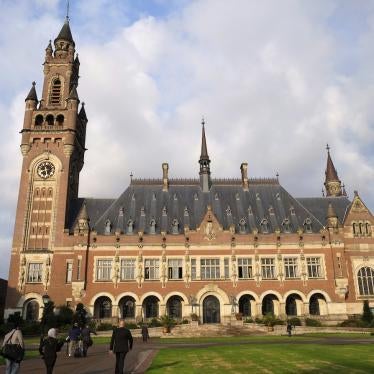Your Excellency,
We write to urge your delegation to work with other member and observer states of the United Nations Human Rights Council (HRC) to bring the issue of accountability for wartime abuses in Sri Lanka onto the agenda of the Council during its March 2012 session. Almost three years after the end of the military conflict between the Sri Lankan government and the separatist Liberation Tigers of Tamil Eelam (LTTE), the government has not kept its commitments to the people of Sri Lanka, the UN Secretary-General, and the Human Rights Council to undertake credible measures to provide justice and accountability for the widespread and serious wartime abuses.
Violations of international human rights and humanitarian law, including alleged war crimes and crimes against humanity, remain unaddressed by the Sri Lankan government, even after the long-delayed report by the government’s Lessons Learnt and Reconciliation Commission (LLRC). While containing some useful recommendations, the LLRCdisregarded the worst abuses by government forces and failed to recommend measures to hold accountablegovernment and military officials responsible for abuses.
Several UN officials, including the High Commissioner for Human Rights, Navi Pillay, and the then-Special Rapporteur on extrajudicial, summary or arbitrary executions, Philip Alston, have called for an independent, international investigation into allegations of international human rights and humanitarian law during the conflict. Human Rights Watch and many other domestic and international nongovernmental organizations have long called for such an international investigation.
As the leading intergovernmental body devoted to the protection of human rights, it is crucial that the HRC support the steps necessary to ensure that the deaths and injuries to tens of thousands of civilians in the last months of Sri Lanka’sconflict are properly investigated,the perpetrators of abuses are brought to justice, and that victims obtain redress. We therefore urge your delegation to support a resolution at the HRC that:
- Expresses grave concern that the government of Sri Lanka has failed to genuinely and seriously investigate crimes committed during the conflict by all parties and to provide accountability for serious abuses, in violation of its international legal obligations.
- Calls on the HRC to adopt measures to implement the recommendations made to the Secretary-General by the Panel of Experts. This includes establishing an independent international mechanism to monitor and assess the extent to which the Sri Lankan government is carrying out an effective domestic accountability process, to conduct investigations independently into the alleged violations, and to collect and safeguard for appropriate future use information provided to it.
The issue of accountability for wartime abuses has long been a concern of the United Nations. After the defeat of the LTTE in May 2009, Sri Lankan President Mahinda Rajapaksa agreed to a statement with Secretary-General Ban Ki-moon in which he promised to address violations of international humanitarian and human rights law.[1]In May 2010, President Rajapaksa established the LLRC, which was designed to examine the circumstances that led to the breakdown of the 2002 Ceasefire Agreement and recommend action to foster reconciliation. The LLRC was not set up as a vehicle for justice and accountability. However, under increasing pressure for its failure to take act on these issues, the government extended the mandate of the LLRC to wartime abuses. As the Panel of Experts report concluded, theLLRC’s mandate, composition, and methodology were wholly inadequate if the government were serious about justice and accountability.
After the establishment of the LLRC, the Sri Lankan authorities refused to undertake measures to provide justice and accountability for abuses, telling concerned governments and international actors to wait for the report of the LLRC. During this time, top government officials repeatedly denied that government forces committed any violations. Amidst overwhelming evidence, a few senior officials have recently conceded that government forces caused some civilian casualties, though they continue to grossly downplay the scale of civilian casualties and the security forces’ repeated use of heavy weaponry in indiscriminate and possibly deliberate attacks on civilians and hospitals. The government has not initiated any efforts to prosecute those responsible or suggested that this will happen.
A month after the establishment of the LLRC, Secretary-General Ban in June 2010 established a Panel of Experts in response to President Rajapaksa’s failure to implement his May 2009 promise for accountability. The Panel of Experts, made up of Marzuki Darusman from Indonesia, Yasmin Sooka from South Africa, and Stephen Ratner from the United States, was tasked to advise the Secretary-General on next steps for accountability in Sri Lanka.
On April 12, 2011, the Panel of Experts submittedits report to the Secretary-General. The Panelfound “credible allegations, which if proven, indicate that a wide range of serious violations of international humanitarian law and international human rights law was committed” by both sides to the conflict.[2]The LLRC report, issued in December 2011 after a several-months’ delay to review the Panel report, largely ignored the Panel’s detailed findings on government abuses. Although concluding that there had been civilian casualties attributable to “crossfire,” and calling for investigations into a handful of minor incidents, the LLRC largely exonerated the military’s wartime actions. stating that it was “satisfied that the military strategy that was adopted to secure theLTTE held areas was one that was carefully conceived, in which the protection of thecivilian population was given the highest priority.”
Sri Lanka has a long history of failed promises to prosecute serious human rights abuses or to act on the recommendations of numerous domestic commissions of inquiry into rights violations. For example, the 2006 Presidential Commission of Inquiry was established to investigate 16 incidents of killings, enforced disappearances, and other serious abuses by both sides to the conflict. It was a national commission plus an International Independent Group of Eminent Persons (IIGEP)—including former Indian Chief Justice P.N. Bhagwati, Bernard Kouchner, and former UN special rapporteur Nigel Rodley—which was to oversee the commission’s work to ensure independence and legitimacy. However, in April 2008 the IIGEP members withdrew because the IIGEP had "not been able to conclude ... that the proceedings of the Commission have been transparent or have satisfied basic international norms and standards."
Attached to this letter is a briefing note on the nature and scope of the violations of international human rights and humanitarian law committed in Sri Lanka during the last months of the conflict and on the conclusions of the reports of both the UN Secretary-General’s Panel of Experts and the Lessons Learnt and Reconciliation Commission.
Given the failure of the government to pursue justice and accountability, the HRC should take the lead on behalf of victims of Sri Lanka’s brutal conflict. The March 2012 session of the HRC is the appropriate time and forum for a discussion of Sri Lanka and for a resolution to create an independent international mechanism to investigateinto allegations of international human rights and humanitarian law. The failure of the Human Rights Council to respond to one of the worst episodes of human rights abuse since its creation would severely undermine the relevance and legitimacy of this body.
Thank you for your attention to these urgent issues. Please feel free to contact us to discuss this or for further information.
Yours sincerely,
Brad Adams Philippe Dam
Asia Director Geneva
Briefing Note on the Need for an Independent International Mechanism
into Wartime Abuses in Sri Lanka
The Civilian Cost of the Conflict
The armed conflict that broke out between the Sri Lankan government and the secessionist Liberation Tigers of Tamil Eelam (LTTE) in 1983took a huge toll on civilians, particularly in the country’s north and east.An estimated 80,000 to 100,000 civilians were killed during the 26-year long war.[3]Human rights abuses, including killings, torture and enforced disappearances, were rampant by both sides. A ceasefire agreement signed in 2002broke down by 2005 and major military operations resumed.
Throughout 2008 and 2009, the government’smilitary offensive resulted in a major LTTE retreat,and the LTTE forcedmore than 300,000 ethnic Tamil civiliansto retreat with them.After the fall of their major strongholds and administrative centers, the remaining LTTE forces and their captive civilians set up defensive positions along a narrow stretch of land in the northeastern corner of the country. Here the final battle took placeover the course of several months.
In the final two years of the war and its aftermath, the Sri Lankan government persistently denied independent media, human rights organizations and humanitarian agencies access to the war zone. In September 2008, the Sri Lankan authorities ordered all international organizations, including most UN agencies, to leave northern Sri Lanka.It was nonetheless possible for human rights monitoring groups to obtain information during the fighting through cell phone and internet communications with civilians on the ground, satellite imagery, and other sources of information.
The fighting during the final months of the conflict was particularly brutal. Government forces routinely shelled and bombed the battle zone with little regard for the densely packed civilian population, which lacked food, water and health care. The LTTE effectively used the population as “human shields” and fired upon families that sought to escape the fighting. Information collected by the UN indicates that at least 7,000 civilians were killed between January and the end of April, though the actual number is likely much higher. Witnesses reported rapidly increasing numbers of civilian casualties in the conflict’s last few weeks. Some individual UN staff, using internal UN reporting,have estimated there were as many as 20,000-30,000 civilian deaths. Other sources have estimated the number of civilian deaths in the tens of thousands.[4]
For more than six months following the war, nearly 300,000 displaced civilians were locked up in camps in northern Sri Lanka with limited access to the outside world. Access to resettled areas in the former war zone is still strictly limited.
Violations by government forces
Indiscriminate shelling
Eyewitness accounts and satellite imagery show that Sri Lankan government forces indiscriminately attacked areas densely populated with civilians in violation of international humanitarian law (the laws of war). Government forces continued to use heavy weapons – despite denials that they were doing so – despite being aware, such as through aerial drones, that they were causing massive civilian casualties.
During the five last months of the conflict, the government unilaterally declared three successively smaller “no-fire” zones for civilians, urging civilians to gather in these areas. Shelling in these areas continued, however, contributing to the high civilian casualty rate.
Attacks on hospitals
In indiscriminate artillery and aerial attacks, the Sri Lankan armed forces repeatedly struck hospitals in the war zone and the government-declared “no-fire” zones. Patients, medical staff, aid workers, and other witnesses provided Human Rights Watch with information about at least 30 attacks on permanent and makeshift hospitals in the combat area between December 2008 and the end of the war.[5]Medical personnel told Human Rights Watch that they had communicated the location of hospitals to the Sri Lankan government, and eyewitness accounts and satellite imagery indicate that many of the hospitals were clearly marked.
Some of the most serious attacks include repeating shelling of the Puthukudiyiruppu hospital in early February 2009, which forced the hospital staff and patients to evacuate to a make-shift hospital in Putumattalan.[6]Several attacks in May 2009 caused high civilian casualties. One of the deadliest took place on May 2, 2009, when artillery shells struck Mullaivaikal hospital in the "no-fire zone," killing 68 people and wounding 87.
Extrajudicial executions
Human Rights Watch has received credible information about several incidents of extrajudicial executions of suspected LTTE cadres held in government custody. In at least two cases there is video and photographic evidence to support the allegations.[7]In one case, a five-minute-long video, apparently recorded on May 18, 2009, the last day of the war, shows what appears to be government soldiers executing undressed, blindfolded and handcuffed prisoners in their custody. At least a dozen dead bodies are visible on the video and on several photographs of the same incident. One of the dead bodies in the video and photographs is of a woman named Isaippiriya, a 27-year-old reporter for the LTTE. A statement on the website of the Sri Lankan Ministry of Defense claims that Isaippiriya had been killed by the Sri Lankan army’s 53rddivision, linking that division to the executions seen in the video.[8]Some of this footage has been aired on the Channel 4 documentary, Sri Lanka’s Killing Fields,in 2011.
Soon after the broadcast of the video in August 2009, the Sri Lankan government announced that four hand-picked local investigators, two of whom were government officials, had concluded that the video was "fake." But the government failed to provide details to support such a finding. The authenticity of the video was strongly supported by independent expert analysis commissioned by the United Nations Special Rapporteur on extrajudicial, summary or arbitrary executions.[9]
Enforced Disappearances
Enforced disappearances were a hallmark of the conflict in Sri Lanka. Government commissions found that tens of thousands of persons have “disappeared.”[10]A 2008 Human Rights Watch report uncovered an upsurge in new cases of enforced disappearances after the collapse of the ceasefire in 2005, including in Colombo and other areas of the country far from the fighting.[11]There were numerous allegations of enforced disappearances at war’s end when government forces screened and registered suspected LTTE cadres.[12]The government has heightened concerns for individuals missing and believed to have been “disappeared” by denying access to the war zone, the screening process and the camps, and its refusal to publish lists of suspected LTTE cadres in detention.
In one incident, several people witnessed government soldiers taking away several dozen suspected LTTE leaders and a priest on May 18, 2009. None of the detainees have been seen or heard from since.[13]In another case, a video has surfaced apparently showing government soldiers interrogating a senior LTTE officer, Colonel Ramesh. His family has not heard from him since the end of the war, and his widow has identified him in a photo which emerged in April 2011 showing a bloodied dead body.[14]
Violations by the LTTE
Use of Human Shields
As the LTTE forces retreated in the face of the government’s offensive operations, it forced civilians to retreat with them. The LTTEdeliberately prevented civilians under their control from fleeing to areas away from the fighting, effectively using them as human shields and unnecessarily and unlawfully placing their lives at grave risk.
The LTTE frequently fired on families attempting to flee, killing and wounding many civilians.[15]
Forced Recruitment
The LTTE had a long history of forcibly recruiting civilians to their armed forces, including children as young as 14.[16]As the LTTE’s situation became increasingly desperate, recruitment of children among the Tamil families under their control sharply increased.
While the LTTE recruited civilians on a continual basis, there was at least one incident of massive recruitment during the final months. On March 24, the LTTE surrounded the Valayanmadam church compound where several hundred people had sought refuge from the fighting. The LTTE forces started grabbing people, and within two hours had loaded several hundred young people onto vehicles and drove them to Mullaivaikkal for training.
Exposing Civilians to Unnecessary Harm
LTTE forces frequently deployed mortars and other artillery in or near densely populated areas, exposing civilians to grave risk. Human Rights Watch documented several instances in which LTTE forces exposed civilians to unnecessary danger by using radio equipment among civilians and by attacking government forces from mobile firing positions from densely populated areas, thereby inviting counter-fire from government forces.
UN Panel of Experts report
The UN panel report found credible allegations of grave violations of international humanitarian law by both government forces and by the LTTE. It found evidence that government forces committed murder and torture, intentional attacks on civilians, indiscriminate or disproportionate attacks on civilians, attacks on medical and humanitarian objects, starvation of the population and denial of humanitarian aid, and enforced disappearances. The panel found evidence of LTTE responsibility for murder and torture, for using human shields, and for the forcible recruitment of children.[17]
In light of these findings, the UN panel recommended that the Secretary-General establish an independent international mechanism to concurrently monitor the Sri Lankan government’s investigations into the reported allegations and to conduct its own investigations.[18]The panel did not consider the LLRC, given its mandate, composition and methodology, to be a genuine attempt at accountability.[19]
Previous domestic accountability mechanisms
Sri Lanka has a long history of failed commissions of inquiry. Since 1977, Sri Lanka’s default response to international criticism of its human rights record has been to establish national commissions of inquiry or other ad hoc bodies to investigate human rights violations. The work of many of these commissions has been tainted with political interference and mainly served to exonerate the government security forces. But even in cases where the commissions (like the All-Island Commission on Disappearances) conducted thorough investigations, established numerous cases of abuses, and identified the perpetrators, the authorities failed to act on the commissions’ recommendations and establish a meaningful accountability process. The work of at least 14 previous bodies that were set up to investigate human rights violations committed in Sri Lanka since late 1970 has yielded virtually no tangible results. With the exception of a handful of low-level members of the security forces, no perpetrators have been prosecuted and the victims have seen no redress.
An example of the cynical nature of these commissions of inquiry is best illustrated by the 2006 Presidential Commission of Inquiry and International Independent Group of Eminent Persons (IIGEP). This commission was assigned to investigate 16 incidents of killings, enforced disappearances, assassinations and other serious abuses, including the brutal killing of five students in Trincomalee, the summary execution of 17 aid workers in Mutur, and the bomb attack that killed 68 bus passengers in Kebitigollewa.It was a national commission but a group of international experts, including theIndian former Chief Justice P.N. Bhagwati, French diplomat and co-founder of Medecins Sans Frontier Bernard Kouchner, and leading British human rights lawyer Sir Nigel Rodley, were invited to oversee the work of the national commission as a way to lend it an air of independence and legitimacy.
However, in April 2008, the IIGEP members withdrew from their role because it had "not been able to conclude ... that the proceedings of the Commission have been transparent or have satisfied basic international norms and standards." Even the participation of the most respected international figures was not sufficient to deter the government from obstructing progress in these cases.
The government allowed the commission’s mandate to expire in June 2009, although it had only investigated 7 of its mandated 16 cases. The government has not released any of the commission’s reports or taken any other public action. There has been no apparent progress in criminal investigations related to some of the 16 cases.
Lessons Learnt and Reconciliation Commission
The LLRC was deeply flawed from its inception. The members of the panel could not be seen as independent; the chairman and another member, both senior members of government during the last stages of the war, had publicly defended the government against allegations of war crimes. There is also evidence that the chairman, during his tenure as attorney general, actively undermined the working of the IIGEP Commission of Inquiry. Equally worrying was the absence of any provisions for the protection of victims and witnesses. Given the general climate of impunity and the continued military presence in the north and east, witnesses who came forward to tell their stories did so with great bravery.[20]
Interim recommendations produced by the LLRC in September 2010 did not contain a single recommendation related to justice or accountability; those recommendations largely remain unimplemented.
The LLRC report released in December 2011 contains some useful recommendations on reconciliation and does call for investigations in a handful of specific incidents. However, it is woefully remiss on accountability issues. It disregards the worst abuses by government forces, rehashes longstanding recommendations and offers no realistic pathway for accountability. In the face of overwhelming evidence, it does conclude that there were considerable civilian casualties, but ends up largely exonerating government forces, blaming the casualties, either directly or indirectly, on the LTTE.[21]
The report alsofails to address the use of heavy artillery against civilian areas as possible indiscriminate attacks in violation of the laws of war. While rejecting summarily that the military’s attacks either deliberately targeted civilians or caused disproportionate civilian harm, the LLRC did not even consider whether any attacks failed to discriminate between civilians and combatants, a major finding by the UN panel of experts.[22]
Among its many omissions, the LLRC report does not examine the allegations that government forces executed several LTTE leaders who attempted to surrender to the government forces during the last days of the war in what has been called the “white flag” incident. The report limits its analysis of the so-called Channel 4 video, which appears to show government forces handcuffed and blindfolded as prisoners, to a technical discussion of the video’s authenticity without mentioning the government’s admission that its forces killed a young woman visible in the footage.
The government of Sri Lanka has announced that it will begin implementing the recommendations of the LLRC byaround March 2011. This would be a major reversal of past government practice; as noted, the commission’s interim recommendations have not even been carried out. The government has not only failed to take up accountability but has actively attacked credible efforts to uncover the truth. Senior officials have repeatedly put out statements deriding the members of the UN panel of experts and their report, the Channel 4 video, and human rights groups who challenge the government. They are quick to blame all critics as LTTE supporters or otherwise biased and lacking credibility. The allegations of serious violations during the final stages of the war are far from new. Instead of investigating these, the Sri Lankan government has chosen to play a game of waiting and hoping that international attention will shift elsewhere.
[1]“Joint Statement by UN Secretary-General, Government of Sri Lanka,” UN Department of Public Information, May 26, 2009, http://www.un.org/News/Press/docs/2009/sg2151.doc.htm(accessed January 26, 2012).
[2]Report of the Secretary-General’s Panel of Experts on Accountability in Sri Lanka (UN Panel Report), March 31, 2011, p. 2, http://www.un.org/News/dh/infocus/Sri_Lanka?POE_Report_Full.pdf(accessed January 26, 2012)
[3]“Up to 100,000 killed in Sri Lanka’s civil war: UN,” ABC News, May 20, 2009, http://www.abc.net.au/news/stories/2009/05/20/2576543.htm(accessed March 31, 2011).
[4]Ben Farmer, “Sri Lankan army accused of massacring 20,000 Tamil civilians in finale assault,” The Telegraph, May 29, 2009, http://www.telegraph.co.uk/news/worldnews/asia/srilanka/5405085/Sri-Lankan-army-accused-of-massacring-20000-Tamil-civilians-in-final-assault.html(accessed March 22, 2011).
[5]For more information and a list of documented attacks, see “Sri Lanka: Repeated Shelling of Hospitals Evidence of War Crimes,” Human Rights Watch news release, May 8, 2009, https://www.hrw.org/en/news/2009/05/08/sri-lanka-repeated-shelling-hospitals-evidence-war-crimes.
[6]See Human Rights Watch, War on the Displaced: Sri Lankan Army and LTTE Abuses against Civilians in the Vanni, February 20, 2009, https://www.hrw.org/en/reports/2009/02/19/war-displaced.
[7]“Sri Lanka: New Evidence of Wartime Abuses,” Human Rights Watch news release, May 20, 2010, https://www.hrw.org/en/news/2010/05/20/sri-lanka-new-evidence-wartime-abuses.
[8]“Sri Lanka: Army Unit Linked to Executions,” Human Rights Watch news release, December 8, 2010, https://www.hrw.org/en/news/2010/12/08/sri-lanka-army-unit-linked-executions.
[9]Deeming Sri Lanka execution video authentic, UN expert calls for war crimes probe, UN News Centre, January 7, 2010, http://www.un.org/apps/news/story.asp?NewsID=33423(accessed March 31, 2011).
[10]See, for example, background section in Human Rights Watch, Recurring Nightmare: State Responsibility for “Disappearances” and Abductions in Sri Lanka, August 27, 2008, https://www.hrw.org/en/reports/2008/08/27/recurring-nightmare.
[11]See, for example, Human Rights Watch, Recurring Nightmare.
[12]For more information about the screening process, see Human Rights Watch,Legal Limbo: The Uncertain Fate of Detained LTTE Suspects in Sri Lanka, February 2, 2010, https://www.hrw.org/en/reports/2010/02/02/legal-limbo.
[13]See, for example, SwaminathanNatrajan, “Tamil Tiger’s wife pleads for help in finding him,”BBC, September 24, 2010, http://www.bbc.co.uk/news/world-south-asia-11383437(accessed March 22, 2011).
[14]Dean Nelson and Laura Roberts, “Oxford Union cancels Sri Lankan president’s talk as Tamil groups protest,” The Telegraph, December 1, 2010, http://www.telegraph.co.uk/news/worldnews/asia/srilanka/8174616/Oxford-Union-cancels-Sri-Lankan-presidents-talk-as-Tamil-groups-protest.html(accessed March 22, 2011), “New Evidence leads to war crime committed on LTTE’s Col. Ramesh,” Tamilnet, April 27, 2011, http://www.tamilnet.com/art.html?catid=13&artid=33871.
[15]See, for example, Human Rights Watch, War on the Displaced.
[16]See for example, Human Rights Watch, Living in Fear: Child Soldiers and the Tamil Tigers in Sri Lanka, November 10, 2004, https://www.hrw.org/en/reports/2004/11/10/living-fear-0.
[17]UN Panel Report, p.67.
[18]UN Panel Report, p. vii.
[19]UN Panel Report, p. v.
[20]See “Sri Lanka: New Panel Doesn’t Satisfy US Concerns,” Human Rights Watch news release, May 27, 2010, https://www.hrw.org/en/news/2010/05/27/sri-lanka-new-panel-doesn-t-satisfy-us-concerns.
[21]LLRC report, Chapter 9.6-9.8, pp. 328-329.
[22]LLRC report, Chapter 9.5, p. 328.
